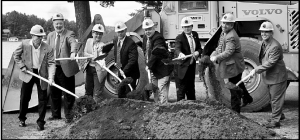Construction begins on wastewater treatment plant, collection System; benefit expected for local environment and economy
State, federal agencies assist town with $4.1 million project

Inlet Supervisor John Frey, fifth from left, breaks ground with visiting officials to commemorate the start of the town’s wastewater collection and processing project.
The Town of Inlet broke ground for the construction of its long-anticipated $4.1 million wastewater treatment plant and collection system on Wednesday, September 5.
The new system is designed to protect the environment and permit commercial development in Inlet, a popular tourist destination.
Local business leaders, along with environmental advocates for the Adirondacks, attended the groundbreaking at Arrowhead Park.
Also participating were officials from the Town of Inlet, Hamilton County, the New York State Environmental Facilities Corp., the New York State Department of Environmental Conservation and the Rural Development Office of the U.S. Department of Agriculture (USDA).
The project is being financed with a $1.734 million grant from the New York State Environ-mental Facilities Corp. (EFC) and a $1.788 million Rural Development grant from the USDA.
The project which had been well along in the planning stage, was put in jeopardy last year when construction bids came in far above anticipated figures.The project was saved when EFC President and CEO Matthew Driscoll announced that Inlet would receive an additional $1.534 million on top of a $200,000 grant that EFC had previously committed to the project.
At Wednesday’s groundbreaking, Driscoll discussed the importance of the Inlet project.
“Replacing private septic tanks with a modern wastewater treatment system will help protect the environment and public health of this community and the thousands of people who visit Inlet each year,” he said.
Specifically, the new sewer system will help protect Fourth Lake by collecting and treating wastewater that is now handled by privately-owned septic systems.
The treatment facility will be built near the Hamlet Center at the base of Fern Mountain.
A collection system with new pump stations, a force main and gravity sewers will be installed.
Served by the system will be the town’s 400 residents, along with the thousands of visitors who come to Inlet and three state campgrounds each year.
And New York State is glad to be helping make the sewer project a reality, according to Driscoll.
“[It] is giving Inlet the opportunity to grow economically and take full advantage of its appeal as a major tourism destination,” he said.
Also pleased is Inlet Town Supervisor John Frey, who has been instrumental in guiding the project through its ups and downs.
“Inlet is ‘Open for Business,’” he said, adding that the project has already made an economic impact.
“A vacant building has been purchased and is already undergoing renovation bringing year round jobs with it.
“Other locations are adding services that could not be provided without updated and costly septic systems. We are very thankful that this Governor, EFC and USDA RD understood the needs and found a way to make it come together,” Frey said.
Department of Environmental Conservation Commissioner Joe Martens commended Supervisor Frey and the Town of Inlet for its diligence.
“Implementing a successful municipal wastewater project can be a challenge, especially for small communities,” he said.
“EFC and the Town of Inlet have found a way to overcome the obstacles.”
Bryan Clerkin, USDA Acting State Director, described the agency as a proud partner on the project.
“Any time we help a rural community achieve its goal of improving the quality of life for it citizens… we are fulfilling our mission. This project in particular is important because it creates jobs, provides a sustainable infrastructure, and mitigates health hazards,” he said.
William G. Farber, Chairman of the Hamilton County Board of Supervisors, spoke on the board’s behalf in thanking the governor for his leadership, which paved the way for state funding.
“It is exciting to be part of the momentum which is developing in this county and throughout the North Country Region,” he said.
“Projects like the Inlet Wastewater Collection and Treatment System, which have the potential to help transform a Hamlet, are key to our success.”
Leilani Ulrich, Chairwoman of the Adirondack Park Agency (APA), also applauded the project and Inlet’s commitment, and the potential it creates for future growth.
“Public infrastructure is critical to the sustainability of Adirondack Communities like Inlet… Inside the Adirondack Park, municipal infrastructure projects lay the foundation needed to support development that will result in positive regional economic impacts,” she said.
Ulrich commended the governor and NYS Environmental Facilities Corporation for recognizing the essential need of the project.
John Sheehan, Director of Communications for the Adirondack Council, said, “This project will make the Moose River and Fulton Chain of Lakes cleaner and healthier for generations to come. This could not have been accomplished without EFC’s perseverance and its dedication to the Adirondack Park.”
Along with the Adirondack Council, other environmental advocates voiced their support for the Inlet Wastewater initiative.
“This grant and infrastructure projects like this one encourage economic activity in our villages and hamlets, enabling Smart Growth and reducing pollution and other impacts on valuable open space,” said Julie McQuain, Chair, Clean Water/Watersheds Committee of the Sierra Club Atlantic Chapter.
Dave Gibson of Adirondack Wild said high water quality is critical to Inlet, and he described the interconnectedness of the town’s residents, businesses, visitors and outdoor recreationists with the region’s waters and aquatic wildlife.
Matthew J. Cooper, PE, Principal at Bernier, Carr & Associates, described the inadequacy of the current on-site septic systems and their threat to the environment and sustainability of downtown.
“Through the Town’s cooperative efforts with regulatory and funding agencies, a wastewater solution is at hand that will help ensure the future of this wonderful Adirondack community,” he said.
